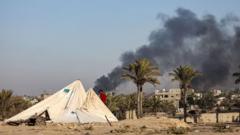What Controversy Surrounds the Cockpit Voices in the Air India Crash?

Understanding the Air India Flight 171 Crash: Insights and Speculations
The tragic crash of Air India Flight 171, which resulted in the loss of 260 lives in June, has left a deep scar on the aviation community and the families of the victims. The preliminary report released following the incident was expected to provide closure, but instead, it has opened the floodgates to speculation and debate. One particularly haunting detail has captured the attention of investigators, aviation analysts, and the public alike: the sudden movement of both fuel-control switches to "cut-off" right after take-off, leading to a catastrophic loss of power. This article delves into the complexities of the incident, the implications of the report, and the ongoing investigation into what truly happened on that fateful day.
The Immediate Aftermath of the Crash
On that tragic day, Air India Flight 171 took off from Ahmedabad, India, and within seconds, it was engulfed in disaster. The aircraft—a 12-year-old Boeing 787—was airborne for less than a minute before crashing into a residential neighborhood. The cockpit voice recording reveals critical exchanges between the pilots, raising questions about the actions taken in those precious moments post-take-off. The co-pilot, Clive Kunder, was at the controls while Captain Sumeet Sabharwal was monitoring. The cockpit conversation captured one pilot questioning the other about the fuel cut-off, which neither claimed to have instigated.
A Closer Look at the Preliminary Report
The 15-page preliminary report aimed to clarify what transpired during those crucial seconds. However, it has instead fueled a firestorm of speculation. Investigators noted that the fuel-control switches were manually moved to the "cut-off" position, an action that typically only occurs after landing. This alarming detail has triggered numerous theories about pilot error, mechanical failure, and even the possibility of deliberate action.
Investigative Challenges
The investigation’s complexity is compounded by the experienced backgrounds of the pilots. Combined, Sabharwal and Kunder had over 19,000 flight hours, with nearly half of that time spent on the Boeing 787. Both pilots had passed pre-flight health checks, which adds another layer of intrigue. The Indian Aircraft Accident Investigation Bureau (AAIB) and the U.S. National Transportation Safety Board (NTSB) are conducting a thorough investigation, but the media's premature conclusions have been met with criticism from both aviation authorities and pilot associations.
Media Speculation and Its Consequences
The rush to speculate about the causes of the crash has drawn ire from aviation professionals. The Indian Commercial Pilots' Association labeled the media's approach as "reckless" and "deeply insensitive." They urge restraint until the comprehensive final report is released. Jennifer Homendy of the NTSB has echoed this sentiment, emphasizing that investigations of such magnitude take time and should not be rushed.
Key Theories Emerging from the Investigation
As the investigation unfolds, several theories have emerged, each with its own implications regarding the causes of the crash. Below are the primary theories that have gained traction:
- Human Error: The most straightforward theory is that one of the pilots inadvertently turned off the fuel switches. The ambiguity surrounding the cockpit conversation raises questions about accountability and decision-making in high-pressure situations.
- Mechanical Failure: Some experts suggest that a glitch in the aircraft's Full Authority Digital Engine Control (FADEC) system could have caused the shutdown. However, this theory is challenged by the timing of the pilot's comments regarding the fuel cut-off.
- Deliberate Action: The possibility of intentional actions taken by one of the pilots has also been floated. If one pilot did turn off the fuel switches knowingly, it raises serious ethical and legal questions.
- Electrical Fire Theory: Another theory posited by Indian media is the occurrence of an electrical fire in the tail section of the aircraft. However, the preliminary report suggests that the engines shut down due to manual intervention rather than an electrical failure.
Importance of the Cockpit Voice Recorder
The cockpit voice recorder (CVR) is a crucial element in understanding the sequence of events leading up to the crash. The preliminary report disclosed only a brief excerpt of the conversation, leaving many vital details undisclosed. Investigators have noted that the full transcript will be essential in determining who said what, and when. The selective disclosure of this information has raised questions about the investigation's confidence level regarding the pilots' identities in the recordings.
Expert Opinions on the Investigation
Experts in aviation safety have weighed in on the investigation, emphasizing the need for caution in drawing conclusions. Shawn Pruchnicki, a former airline accident investigator, warns against jumping to conclusions based on limited information. "It's easy to assume that if the switches were turned off, it must mean intentional action—pilot error, suicide, or something else. And that's a dangerous path to go down with the limited information we have," he says.
Awaiting the Final Report
The final report from the AAIB is expected to take a year or more to complete. It will aim to clarify the root causes and provide recommendations to prevent similar incidents in the future. In the meantime, the aviation community remains on edge, with many anxiously awaiting the findings that could shed light on this tragic event.
Conclusion: The Unanswered Questions
The crash of Air India Flight 171 serves as a grim reminder of the complexities inherent in aviation safety. The speculation surrounding the incident highlights the delicate balance between accountability and transparency in investigations of this magnitude. As we await further developments, one thing remains clear: understanding what happened on that fateful day is essential not only for closure for the victims' families but also for the improvement of aviation safety protocols worldwide.
FAQs about Air India Flight 171
What caused the crash of Air India Flight 171?
The preliminary report indicates that the crash was precipitated by the manual cut-off of fuel switches shortly after take-off, leading to a total power loss. However, the investigation is ongoing, and the final report will provide more definitive answers.
How long will the investigation take?
The comprehensive investigation is estimated to take around a year or more to complete. The final report will aim to clarify the root causes and recommendations to prevent similar tragedies in the future.
What role does the cockpit voice recorder play in investigations?
The cockpit voice recorder captures conversations and sounds in the cockpit, providing vital information about the pilots' actions and decisions leading up to an incident. In this case, the CVR is critical for understanding the sequence of events that led to the crash.
What are the implications of premature media speculation?
Premature media speculation can lead to misinformation and unwarranted blame towards individuals or groups. It can also disrupt the investigative process by influencing public perception and the focus of the investigation.
As we navigate through the uncertainties surrounding the crash of Air India Flight 171, it raises a poignant question: How can we improve the aviation industry’s approach to safety and accountability in the wake of such tragedies? #AirIndia #AviationSafety #Flight171
Published: 2025-07-22 02:09:10 | Category: world



